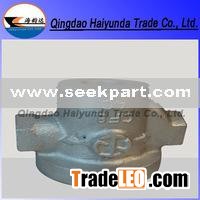Permanent Mold Castings, while not as flexible as sand castings in allowing the use of different patterns (different part designs), lower the cost of producing a part. At a production run of 1000 or more parts, permanent mold castings produce a lower cost per part. Of course, the break-even point depends on the complexity of the part. More complex parts being favored by the use of permanent molds. Instead of using sand as the mold material, a metal is used as a mold. Typically cast iron or Meehanite (a dense cast iron) is used as the mold material and the cores are made from metal or sand. Cavity surfaces are coated with a thin layer of heat resistant material such as clay or sodium silicate.
Permanent Mold or Gravity Die-Casting is mainly used for nonferrous metals and alloys. The mold (or die) is usually iron, steel, or graphite, and is cooled by water channels or by air jets on the outer surfaces. Cavity surfaces in metal dies are coated with a thin layer of heat-resistant material. The mold or die design is usually in two halves, although many multiple-part molds are in use, with loose sand or metal cores to form "undercut" surfaces.
Permanent mold casting is a precision technique produced by pouring molten metal into CNC machined steel molds under gravity, centrifugal force, or low pressure. A permanent steel mold tool is usually made out of H-13 tool steel which allows for a life of 70,000 units if properly maintained. The permanent steel mold tool is created from 3D CAD files to generate a precise, solid tool. By using H-13, tool steel, the unit remains extremely stable and doesn't warp, twist, or check when molten aluminum or zinc is poured into it.
Process:




